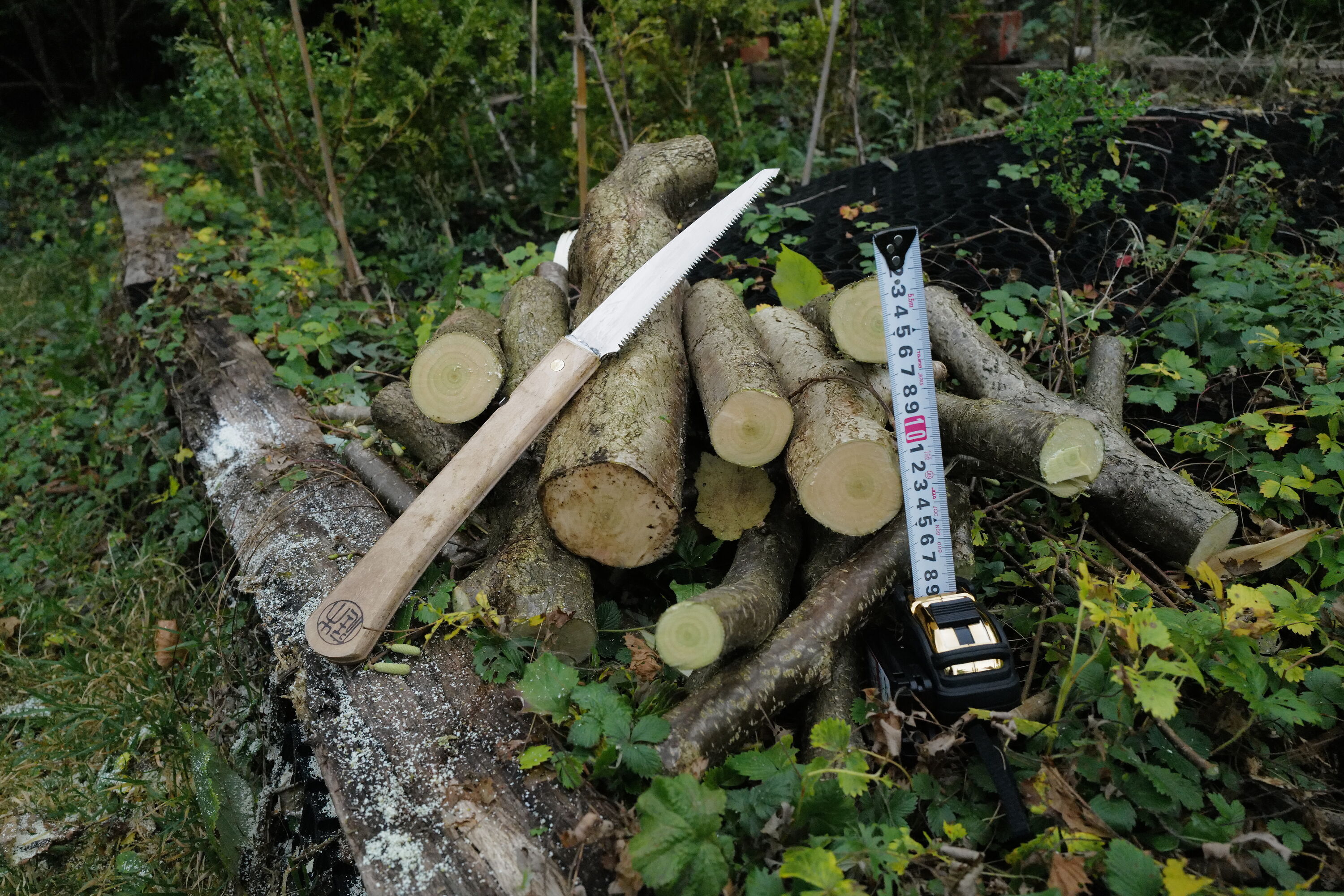Max Cut
We’re often asked ‘how thick a branch can I cut with this?’ when discussing secateurs and saws. For a long time I referred to pencils, held up an appropriate finger, or put my hand around my wrist to offer a dimension that people could relate to. This works as a rough guide, but I always tagged on the caveat ‘it depends what type of wood you’re cutting, the time of year, and what you had for breakfast.’ All of which make a huge difference.
Last weekend, I was working in the garden, thinning some of the trees at the back – kind of an informal hedge between us and the – and I was reminded of the subtleties needed when offering guidance. I started by chopping the top off of a Leylandii (and elegantly thinning what was left, of course). I broke rule No.1 right away, by using too small a saw for the job. I only had a folding saw with me (the Moku Folder, with an 18cm blade) and set to on a trunk that I could just about wrap both hands around, so thumbs were touching on one side, and middle fingers on the other. About 14cm diameter, with an 18cm saw. So it took me ages, and the longer a job takes, the more tired you get, and the more errors you make. But I soldiered on and beheaded my tree.
The general rule of thumb is to limit the diameter of your cuts to 1/3 the length of the blade – so you have the same space either side, giving you a good follow through on each stroke. In this case the wood was soft, as with most conifers (yew wouldn’t have been) but then I moved to an overgrown hazel, and took out a similar sized branch, to let new suckers take over from the bottom. Hazel wood is surprisingly hard – I hadn’t realised this – and it was much more of challenge. I was comprehensively outgunned, and only my superior sawmanship kept me in the game. For efficient cutting I needed a longer blade, especially for the hazel. Yes, I got there in the end, but it took longer, and I risked damaging the blade. So stick to the rule of thirds.
Part two of the job involved cutting the side branches off the trunks I’d sawn. We live in town, and all the waste has to go through a narrow side passage to the front of the house, and on to the dump. I learned long ago that it pays to chop things up neat and small, then carry them through, rather than drag large stuff through. I started on the hazel. Most of the time you’d cut hazel, you’d be coppicing, and perhaps using the fresh young uprights as peasticks and bean frames. This was slightly different - some of the side branches were probably two or three years old, and up to an inch wide (3 cm). I was using a pair of Niwaki GR Pro S-Types, and I’m always keen to give our tools a good workout, test them slightly beyond what I recommend to customers. In this case we suggest 15mm as the max cutting diameter, and I’d say that’s about right but on the 10-20mm branches I struggled occasionally (hazel wood is hard, basically) and I had to think about my cutting action to get things to work efficiently (and occassionally to pull the saw out for the bigger stuff.) The trick is to not cut perpendicularly across the branch - this means you’re cutting straight across the plant fibres, where they’re toughest. Instead, cut at an angle, so you’re cutting along the fibres more. Next I polished off the Leyland branches, and here I easily cut through 30mm, as the wood is so much softer. Of course when you’re brashing like this (cutting down felled branches, rather than pruning) there’s no need to respect the plant - it’s all getting chipped or shredded anyway, so you can use more pressure, pushing down on the branch to ease the cut. Basic rule to follow is: What you CAN do, and what you SHOULD do, are very different.
So, to recap. For secateurs there’s no such thing as an accurate maximum cutting diameter - we use it just to keep people happy. Guage the wood, be reasonable. If you’re doing the odd cut that you know is over the limit, you’ll probably be fine, but if you stick at it all day, something’s going to give.
For saws, try not to overdo it. We all do, and we all know it’s wrong. Try to stick to a maximum branch diameter of about one third of the blade length. Oddly, it can go the other way too - don’t use a massive saw on a very small branch - chances are a thin branch will move around a lot, not offering resistance, and you’ll snag and catch the blade. As much damage happens this way round, chipping a tooth on a small branch. And for breakfast: You’d be forgiven for thinking that a third weetabix makes all the difference, but actually you’d be wrong. Pruning is not about strength or energy, it’s about care - positioning, precision and rhythm, about feeling what you’re doing, responding to the situation, rather than bulldozing through.




